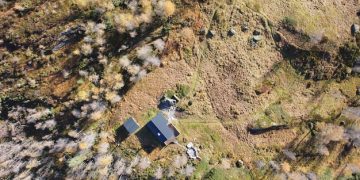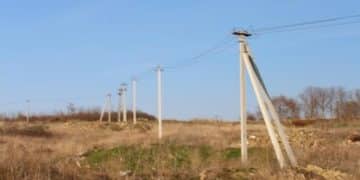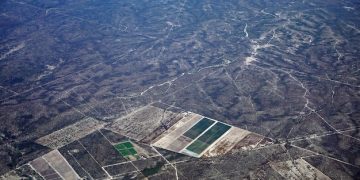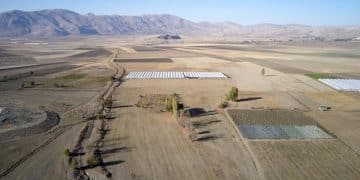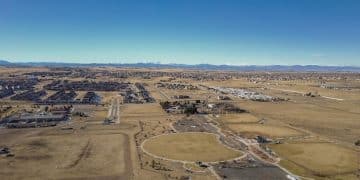Understanding New Federal Guidelines for Environmental Justice in Clean Energy Project Siting

Understanding the New Federal Guidelines for Environmental Justice in Clean Energy Project Siting is crucial as it ensures clean energy projects do not disproportionately harm disadvantaged communities, promoting equitable access to renewable energy benefits and mitigating environmental burdens.
The push for clean energy is gaining momentum, but it’s essential to ensure that this transition doesn’t exacerbate existing inequalities. Understanding the New Federal Guidelines for Environmental Justice in Clean Energy Project Siting is critical because these guidelines aim to protect vulnerable communities from shouldering a disproportionate burden of environmental risks associated with clean energy projects. Let’s dive into what these guidelines entail and what they mean for the future of clean energy in the U.S.
What is Environmental Justice and Why Does It Matter?
Environmental justice is the fair treatment and meaningful involvement of all people regardless of race, color, national origin, or income, with respect to the development, implementation, and enforcement of environmental laws, regulations, and policies. It matters because historically, marginalized communities have been disproportionately exposed to environmental hazards and pollution.
Clean energy projects, while beneficial overall, can still have localized environmental impacts. Without careful planning and consideration, these projects could inadvertently harm the very communities they are intended to benefit. This is where a strong environmental justice framework becomes essential.
The Roots of Environmental Injustice
Environmental injustice is often the result of systemic inequalities and discriminatory practices that have relegated marginalized communities to areas with higher pollution levels and fewer environmental amenities. Understanding this history is vital for addressing current challenges.
- Historical Redlining: Discriminatory housing policies that concentrated minority populations in less desirable areas.
- Industrial Zoning: Placement of polluting industries in or near low-income and minority neighborhoods.
- Lack of Political Power: Limited ability for these communities to influence environmental decision-making.
Addressing environmental justice requires not just technical solutions, but also a commitment to rectifying historical injustices and empowering affected communities.

In conclusion, environmental justice is crucial because it addresses historical inequities and ensures that the benefits of clean energy are shared equitably while minimizing potential harms to vulnerable communities.
Key Components of the New Federal Guidelines
The new federal guidelines for environmental justice in clean energy project siting are designed to ensure that environmental justice considerations are integrated into the planning, development, and operation of clean energy projects. These guidelines aim to promote fairness, transparency, and community engagement.
The guidelines cover a range of elements, from initial project planning to ongoing monitoring and evaluation. They emphasize the importance of identifying and addressing potential adverse impacts on environmental justice communities.
Community Engagement and Consultation
One of the cornerstones of the new guidelines is robust community engagement. Project developers are expected to actively involve affected communities in the decision-making process, ensuring their voices are heard and their concerns are addressed.
This involves:
- Early and Frequent Communication: Establishing communication channels from the outset of the project.
- Meaningful Consultation: Seeking input and feedback from community members at key stages.
- Culturally Appropriate Outreach: Tailoring communication methods to the specific needs and preferences of the community.
Effective community engagement can lead to better project outcomes and stronger community support.
Another critical aspect of the guidelines is the requirement for project developers to conduct thorough environmental and health impact assessments, specifically focusing on potential effects on environmental justice communities.
Lastly, the guidelines emphasize data collection and transparency, requiring project developers to collect and disclose data on environmental and health impacts, as well as demographic information about affected communities. This information can be used to track progress and identify areas for improvement.

In summary, the new federal guidelines emphasize community engagement, impact assessments, and data transparency to ensure environmental justice is integrated into clean energy project development.
How the Guidelines Impact Clean Energy Project Development
For clean energy developers, the new federal guidelines represent a significant shift in how projects are planned and executed. They necessitate a more proactive and community-centered approach, requiring developers to go beyond traditional environmental compliance measures.
The guidelines may increase initial project costs and timelines due to the need for more extensive community engagement and impact assessments. However, these upfront investments can lead to smoother project implementation and reduced risk of costly delays or legal challenges down the line.
Navigating the Regulatory Landscape
Developers need to be aware of the specific requirements of the guidelines and how they align with existing federal, state, and local regulations. This may involve engaging legal and environmental consultants with expertise in environmental justice issues.
Key considerations include:
- Identifying Environmental Justice Communities: Determining which communities may be disproportionately affected by the project.
- Conducting Impact Assessments: Evaluating potential environmental and health impacts on these communities.
- Developing Mitigation Plans: Implementing measures to minimize or offset any adverse impacts.
By proactively addressing environmental justice concerns, developers can build stronger relationships with communities and improve the overall sustainability of their projects.
Furthermore, the guidelines may create new business opportunities for companies specializing in community engagement, environmental consulting, and renewable energy technologies that minimize environmental impacts.
In conclusion, the guidelines reshape clean energy project development by requiring proactive community engagement, thorough impact assessments, and strategic navigation of the regulatory landscape, fostering sustainable and equitable projects.
Challenges in Implementing Environmental Justice Guidelines
While the new federal guidelines represent a significant step forward, there are challenges in ensuring their effective implementation. These challenges range from defining and identifying environmental justice communities to measuring and mitigating cumulative impacts.
One of the primary challenges is defining an environmental justice community. Factors such as race, income, education, and access to healthcare can all contribute to a community’s vulnerability to environmental hazards. Accurate and consistent identification is essential for ensuring that resources are targeted effectively.
Measuring Cumulative Impacts
Environmental justice communities often face multiple sources of pollution and environmental stress. Measuring and mitigating the cumulative impacts of these stressors can be complex and require sophisticated analytical tools.
This involves:
- Data Collection: Gathering comprehensive data on existing environmental conditions and health outcomes.
- Modeling and Analysis: Using models to predict the combined effects of multiple stressors.
- Mitigation Strategies: Developing strategies to address cumulative impacts, rather than focusing solely on individual projects.
Effective implementation requires collaboration among government agencies, project developers, community organizations, and academic researchers. This collaboration can help to build trust and ensure that diverse perspectives are considered.
In addition, there is the challenge of ensuring equitable enforcement of environmental regulations. Environmental justice communities are in need of greater resources to advocate for their rights and hold polluters accountable.
In summary, effective implementation of environmental justice guidelines requires addressing definition challenges, measuring cumulative impacts, collaborative efforts, and equitable enforcement to ensure meaningful protection for vulnerable communities.
Success Stories: Environmental Justice in Action
While challenges remain, there are examples of successful interventions that demonstrate the viability of environmental justice principles. These success stories show how community engagement, innovative technologies, and policy changes can lead to more equitable and sustainable outcomes.
One example is the revitalization of brownfield sites in marginalized communities. By cleaning up contaminated land and redeveloping it for productive uses, these projects not only improve environmental quality but also create jobs and economic opportunities.
Community-Led Initiatives
Many successful environmental justice projects are driven by community-led initiatives. These initiatives often involve local residents in the planning, implementation, and monitoring of projects, ensuring that they are responsive to community needs and priorities.
These projects often include:
- Community Air Monitoring Programs: Empowering residents to collect and analyze air quality data.
- Green Infrastructure Projects: Implementing nature-based solutions to reduce pollution and improve community resilience.
- Energy Efficiency Programs: Helping low-income households reduce their energy consumption and lower their utility bills.
Moreover, policy changes at the local, state, and federal levels can support environmental justice efforts. This includes policies that promote sustainable development, reduce pollution, and ensure meaningful community engagement in decision-making processes.
In conclusion, revitalization of brownfield sites, community-led initiatives, and supportive policy changes exemplify successful interventions that demonstrate the promise and viability of environmental justice in action.
The Future of Environmental Justice and Clean Energy
The intersection of environmental justice and clean energy is poised to become even more critical in the years to come. As the U.S. transitions to a low-carbon economy, it’s essential to ensure that this transition benefits all communities and does not exacerbate existing inequalities.
Technological innovations, such as distributed solar energy and energy storage, have the potential to empower communities and reduce their reliance on centralized energy systems. These technologies can also create new jobs and economic opportunities in marginalized communities.
Policy and Advocacy
Continued policy and advocacy efforts are needed to ensure that environmental justice considerations are integrated into all aspects of energy policy. This includes policies that promote renewable energy, energy efficiency, and pollution reduction.
Key areas of focus include:
- Funding for Environmental Justice Initiatives: Allocating resources to support community-led projects and research.
- Strengthening Environmental Regulations: Enforcing environmental laws and holding polluters accountable.
- Promoting Equitable Access to Clean Energy: Ensuring that all communities have access to affordable and reliable clean energy.
Education and awareness-raising are also essential for advancing environmental justice. By educating policymakers, project developers, and the public about the importance of environmental justice, we can build a broader base of support for equitable and sustainable energy policies. Finally, advancing environmental innovation and collaboration is key for long-term success.
In summary, technological innovation, supportive policy and advocacy, education, and collaborative efforts are essential components for ensuring the future convergence of environmental justice and clean energy.
| Key Topic | Brief Description |
|---|---|
| 🌱 Environmental Justice | Fair treatment and meaningful involvement of all people. |
| 🤝 Community Engagement | Actively involving communities in project decisions. |
| 📊 Impact Assessments | Evaluating project effects on environmental justice communities. |
| 💡 Policy & Advocacy | Promoting equitable access to clean energy for all. |
Frequently Asked Questions
▼
The main purpose is to ensure that all communities, regardless of race or income, receive equal protection under environmental laws and regulations, promoting fairness and equity.
▼
The guidelines ensure that clean energy projects do not disproportionately impact disadvantaged communities, requiring developers to consider environmental and health impacts on these areas.
▼
Environmental justice communities are often those with a high percentage of minority or low-income residents who face disproportionate exposure to environmental risks and hazards.
▼
Challenges include defining environmental justice communities, assessing cumulative impacts, ensuring community engagement, and enforcing regulations effectively and equitably.
▼
Communities can benefit through cleaner environments, improved health outcomes, increased job opportunities, and greater participation in decision-making processes related to energy projects.
Conclusion
Understanding the New Federal Guidelines for Environmental Justice in Clean Energy Project Siting is paramount for creating a sustainable and equitable energy future. By prioritizing community engagement, conducting thorough impact assessments, and implementing robust mitigation strategies, we can ensure that the benefits of clean energy are shared by all, regardless of race or income, fostering healthier and more resilient communities.
